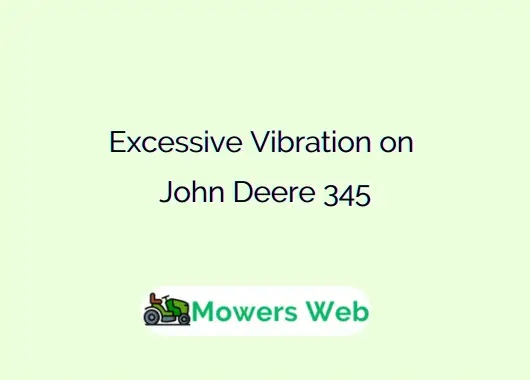Excessive vibration is a common issue that can disrupt performance, cause premature wear, and pose safety risks if ignored. This post guide explores the causes of vibration, diagnostic steps, solutions, and preventive measures to keep your JD 345 running smoothly.
Excessive Vibration on John Deere 345
Vibration in the JD 345 typically arises from imbalances or mechanical issues in rotating components like mower blades, the engine, or drive belts. These high-speed parts must operate in harmony, and any disruption, such as wear, damage, or misalignment, leads to shaking felt through the seat, steering wheel, or chassis.
Left unchecked, this can damage spindles, crack the mower deck, or strain the engine, leading to expensive repairs.
Common Causes of Vibration
Blade-Related Issues
Mower blades are a frequent source of vibration. Striking rocks, roots, or debris can bend or chip blades, creating an imbalance during rotation. This often manifests as a rattling or shaking sensation, especially at higher RPMs. Dull or improperly sharpened blades can also wobble, amplifying vibrations. Loose blade bolts, which loosen over time due to constant motion, are another simple yet common cause.
Mower Deck Problems
The mower deck itself can contribute to vibrations. Worn spindle bearings, which support the blade shafts under heavy loads, often fail, producing a grinding noise and shaking. Idler pulleys and tensioners that guide the deck belt can wear out, causing belt slippage or bouncing. Frayed, stretched, or improperly tensioned drive belts may slap against components, mimicking vibration.
Engine and Transmission Issues
The FD611V liquid-cooled V-twin engine can develop issues like worn connecting rod bearings or piston slap, leading to rattling or knocking that feels like vibration. Loose engine mounts allow the powerplant to shift, transmitting shakes to the chassis. Fuel system problems, such as a sticking choke or dirty carburetor, can cause engine surging, resulting in uneven operation. Low idle speeds, particularly below 2000 RPM, can also exacerbate shaking in older models like the 345.
Related Riding Mower Making Noise When Blades Are Engaged(Fixed)
Diagnosing and Fixing Excessive Vibration
Diagnosing vibration starts with a systematic inspection, followed by targeted repairs. Below are step-by-step solutions to common issues.
Step 1: Inspect the Blades
Always prioritize safety: park on a level surface, turn off the engine, and disconnect the spark plug. Remove the blades and check for bends, chips, or imbalance using a blade balancer tool. Unbalanced or damaged blades should be sharpened or replaced with OEM John Deere blades for optimal fit.
Step 2: Examine the Mower Deck
Inspect the deck for loose bolts or cracked hangers. Wiggle the spindles to detect play, which indicates worn bearings. Spin pulleys by hand to check for rough bearings or wobble. Verify belt tension, there should be about 1/2 inch of deflection midway between pulleys, as specified in the owner’s manual.
Related Mower Blade Sharpening Machine(Top 3 Best 2025)
Step 3: Check the Engine
Listen for rattles using a mechanic’s stethoscope to pinpoint engine issues. Check oil levels, as low oil can cause knocking. Inspect engine mounts for cracks or looseness. If surging is present, clean the carburetor or adjust the choke to ensure smooth operation.
Step 4: Repair Solutions
- Blade Fixes: Balancing or replacing blades is straightforward, costing under $50 and taking about 30 minutes. Use a torque wrench to secure blade bolts properly.
- Spindle Bearings: Replace worn bearings with a rebuild kit, typically $20 per spindle. Online tutorials can guide you through pressing out old bearings and installing new ones.
- Belt Replacement: Install a new drive belt, routing it per the owner’s manual diagram, and adjust tensioners to eliminate slack. This is a DIY-friendly repair that restores smooth operation.
- Engine Repairs: Tighten loose pulleys or clean the carburetor to address surging. For worn bearings or complex engine issues, consult a professional mechanic, as a teardown may be required. Use genuine John Deere parts, like the AM109371 oil pump kit, for compatibility.
Related John Deere Mower Blade Torque Specs(The Ultimate Guide)
Preventing Future Vibration Issues
Regular maintenance is the best defense against excessive vibration. Sharpen blades every 25 hours of use, grease fittings weekly, and replace belts annually to ensure smooth operation.
Avoid mowing wet grass or rough terrain to minimize impacts on blades and the deck. Store your JD 345 in a dry garage to prevent rust on bearings. Secure the battery to avoid electrical vibrations, as John Deere batteries are designed to withstand shaking.
FAQs
Why is my lawn mower vibrating more than usual?
Excessive vibration often comes from unbalanced or damaged mower blades, loose bolts, or worn deck bearings. Blades can bend, hitting debris, causing shaking. Worn spindle bearings or loose belts also contribute. Fix: Check blades for damage, balance or replace them, tighten bolts, and inspect bearings.
Related Mower Blade Angle Chart(For All Mower Brands)
What is the main cause of excessive vibration in a motor?
The JD 345’s Kawasaki FD611V engine vibrates due to worn bearings, piston slap, or loose mounts. Fuel issues, like a dirty carburetor, cause surging, mimicking vibration. Fix: Check oil, tighten mounts, clean carburetor, or consult a mechanic for internal repairs.
What causes excessive vibration while driving?
Vibration while driving stems from loose or frayed drive belts, worn pulleys, or unbalanced blades. Loose engine mounts or deck issues can worsen it. Fix: Adjust belt tension (1/2 inch deflection), replace worn belts, and check deck components.
How to solve vibration problems?
- Blades: Disconnect spark plug, remove blades, check for damage, and balance or replace ($30–50).
- Deck: Inspect for loose bolts, worn bearings ($20/kit), or slack belts; adjust or replace.
- Engine: Check mounts, oil, and carburetor; clean or tighten as needed. Use OEM parts. For complex engine issues, see a mechanic.
Related Lawn Mower Blade Height Chart(For ALL Models)
Why is my lawn mower pulsating while running?
Pulsating is usually engine surging from a dirty carburetor, clogged fuel filter, or low idle (below 2000 RPM). Fix: Clean carburetor, replace filter, adjust idle, or check for loose pulleys.
Final words
Excessive vibration in your John Deere 345 doesn’t have to derail your lawn care routine. By identifying causes like unbalanced blades, worn bearings, or belt issues and addressing them promptly, you can restore a smooth, efficient ride. Most fixes are accessible to DIYers with basic tools and genuine parts.
For persistent problems, professional service may be necessary, but proactive maintenance will keep your tractor humming with power, not vibrations.




